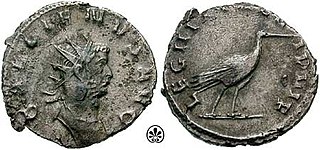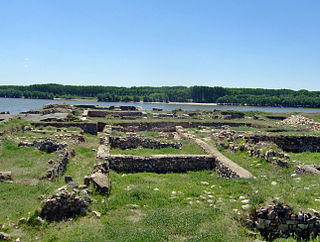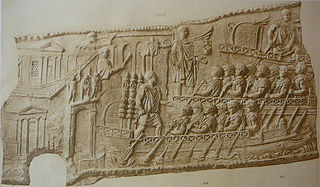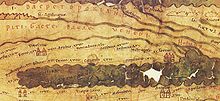
Moesia was an ancient region and later Roman province situated in the Balkans south of the Danube River. As a Roman domain Moesia was administered at first by the governor of Noricum as 'Civitates of Moesia and Triballia'. It included most of the territory of modern eastern Serbia, Kosovo, north-eastern Albania, northern parts of North Macedonia, Northern Bulgaria, Romanian Dobruja and small parts of Southern Ukraine.

Legio I Italica was a legion of the Imperial Roman army founded by emperor Nero on September 22, 66. Originally named Legio Phalanx Alexandri Magni, it was stationed in Italy during the year of four emperors and gained the name Italica. It was later stationed at Novae, near modern-day Svishtov (Bulgaria). There are still records of the I Italica on the Danube border at the beginning of the 5th century. The emblem of the legion was a boar.

Legio III Italica was a legion of the Imperial Roman army founded in 165 AD by the emperor Marcus Aurelius for his campaign against the Marcomanni tribe. The cognomen Italica suggests that the legion's original recruits were drawn for the defence of Italy. The legion was still active in Raetia and other provinces in the early 5th century.

Isaccea is a small town in Tulcea County, in Northern Dobruja, Romania, on the right bank of the Danube, 35 km north-west of Tulcea. According to the 2021 census, it has a population of 4,408.

Novae was initially one of the few great Roman legionary fortresses along the empire's border, forming part of the defences along the Danube in northern Bulgaria. The settlement later expanded into a town in the Roman province of Moesia Inferior, later Moesia Secunda.
The naval forces of the ancient Roman state were instrumental in the Roman conquest of the Mediterranean Basin, but it never enjoyed the prestige of the Roman legions. Throughout their history, the Romans remained a primarily land-based people and relied partially on their more nautically inclined subjects, such as the Greeks and the Egyptians, to build their ships. Because of that, the navy was never completely embraced by the Roman state, and deemed somewhat "un-Roman".

Legio V Macedonica was a Roman legion. It was probably originally levied in 43 BC by consul Gaius Vibius Pansa Caetronianus and Gaius Julius Caesar Octavianus. It was based in the Balkan provinces of Macedonia, Moesia and Dacia. In the Notitia Dignitatum records from beginning of the fifth century, the legion was still stationed in Dacia, with detachments stationed in the east and Egypt.

Legio IV Flavia Felix, was a legion of the Imperial Roman army founded in AD 70 by the emperor Vespasian from the cadre of the disbanded Legio IV Macedonica. The legion was active in Moesia Superior in the first half of the 5th century. The legion symbol was a lion.
Legio I Iovia was a Roman legion, levied by Emperor Diocletian (284–305), possibly together with II Herculia, to guard the newly created province of Scythia Minor. The cognomen of this legion came from Diocletian's attribute Iovianus, "similar to Jupiter". It was based at Noviodunum ad Istrum. According to Notitia Dignitatum, at the beginning of the 5th century I Iovia was still in its camp on the Danube. The legion may have even survived the fall of Rome and continued to serve the Byzantine empire.

Dinogetia was an ancient Geto-Dacian settlement and later Roman fort located not far from the right (southern) bank of the Danube near the junction of the Siret River. The Dinogetia site is situated in Northern Dobruja, Romania, 8 km east of Galați and 2 km north of Garvăn, a village in Jijila commune.

Ratiaria was a city founded by the Moesians, a Daco-Thracian tribe, in the 4th century BC, along the river Danube. In Roman times it was named Colonia Ulpia Traiana Ratiaria.

The Moesian Limes is the modern term given to a linked series of Roman forts on the northern frontier of the Roman province of Moesia along the Danube between the Black Sea shore and Pannonia and dating from the 1st century AD. It was the eastern section of the so-called Danubian Limes and protected the Roman provinces of Upper and Lower Moesia south of the river. The eastern section is often called the limes Scythiae minoris as it was located in the late Roman province of Scythia Minor.

Civitas Tropaensium or Tropaeum Traiani was a Roman city situated in the Roman province of Moesia near modern Adamclisi in Constanța County, Romania. It was named after Trajan's Trophy built nearby.

Capidava was originally an important Geto-Dacian centre on the right bank of the Danube. After the Roman conquest, it became a civil and military centre in the province of Moesia Inferior and part of the defensive frontier system of the Moesian Limes along the Danube.

Dierna was a city and fort in the Roman province of Dacia, located near and beneath the present-day town of Orșova, Romania. The vicus of the fort later grew into a city.

Sacidava was a fort in the Roman province of Moesia near the Getic settlement and later Roman city of Sacidava, Moesia that developed around the fort. It is located at Musait between the villages of Rasova and Dunareni, on a high hill on the right bank of the Danube. It is included in the Tabula Peutingeriana as Sagadava and the Notitia Dignitatum as Sacidava.

Carsium was a fort in the Roman province of Moesia in the 1st century AD whose remains are still visible. It was part of the defensive frontier system of the Limes Moesiae along the Danube.

The Classis Flavia Moesica was the Roman Empire's fleet on the lower Danube river, near the Black Sea.

In Roman Dacia, an estimated 50,000 troops were stationed at its height.



















